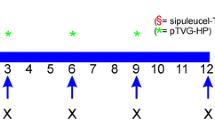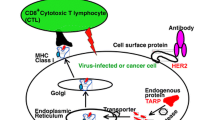Abstract
Prostate specific antigen (PSA) is a serum marker that is widely used in the detection and monitoring of prostate cancer. Though PSA is a self-antigen, T cell responses to PSA epitopes have been detected in healthy men and prostate cancer patients, suggesting it may be used as a target for active immunotherapy of prostate cancer. A PSA DNA vaccine (pPSA) was evaluated in mice and monkeys for its ability to induce antigen-specific immune responses. Mice immunized intradermally with pPSA demonstrated strong PSA-specific humoral and cellular immunity. The anti-PSA immune responses were skewed toward Th1, as shown by high IFNγ and IL-2 production. The immune response was sufficient to protect mice from challenge with PSA-expressing tumor cells. Tumor protection was durable in the absence of additional vaccination, as demonstrated by protection of vaccinated mice from tumor rechallenge. Furthermore, pPSA vaccination induced PSA-specific antibody titers in male cynomolgus monkeys, which express a closely related PSA gene. These results demonstrate that vaccination with pPSA may be able to break tolerance and can induce an immune response that mediates tumor protection.








Similar content being viewed by others
References
Ballangrud AM, Yang WH, Dnistrian A, Lampen NM, Sgouros G (1999) Growth and characterization of LNCaP prostate cancer cell spheroids. Clin Cancer Res 5:3171s–3176s
Bowne WB, Srinivasan R, Wolchok JD, Hawkins WG, Blachere NE, Dyall R, Lewis JJ, Houghton AN (1999) Coupling and uncoupling of tumor immunity and autoimmunity. J Exp Med 190:1717–1722
Catalona WJ, Beiser JA, Smith DS (1997) Serum free prostate specific antigen and prostate specific antigen density measurements for predicting cancer in men with prior negative prostatic biopsies. J Urol 158:2162–2167
Coligan J, Kruisbeek A, Margulies D, Shevach E, Strober W, Colco C (eds) (2003) Current protocols in immunology. In: In vitro assays for mouse lymphocytes function. Wiley, New York
Correale P, Walmsley K, Nieroda C, Zaremba S, Zhu M, Schlom J, Tsang KY (1997) In vitro generation of human cytotoxic T lymphocytes specific for peptides derived from prostate-specific antigen. J Natl Cancer Inst 89:293–300
Correale P, Walmsley K, Zaremba S, Zhu M, Schlom J, Tsang KY (1998) Generation of human cytolytic T lymphocyte lines directed against prostate-specific antigen (PSA) employing a PSA oligoepitope peptide. J Immunol 161:3186–3194
Dudley ME, Wunderlich JR, Robbins PF, Yang JC, Hwu P, Schwartzentruber DJ, Topalian SL, Sherry R, Restifo NP, Hubicki AM, Robinson MR, Raffeld M, Duray P, Seipp CA, Rogers-Freezer L, Morton KE, Mavroukakis SA, White DE, Rosenberg SA (2002) Cancer regression and autoimmunity in patients after clonal repopulation with antitumor lymphocytes. Science 298:850–854
Eder JP, Kantoff PW, Roper K, Xu GX, Bubley GJ, Boyden J, Gritz L, Mazzara G, Oh WK, Arlen P, Tsang KY, Panicali D, Schlom J, Kufe DW (2000) A phase I trial of a recombinant vaccinia virus expressing prostate-specific antigen in advanced prostate cancer. Clin Cancer Res 6:1632–1638
Finn OJ (2003) Cancer vaccines: between the idea and the reality. Nat Rev Immunol 3:630–641
Forg P, von Hoegen P, Dalemans W, Schirrmacher V (1998) Superiority of the ear pinna over muscle tissue as site for DNA vaccination. Gene Ther 5:789–797
Grossfeld GD, Stier DM, Flanders SC, Henning JM, Schonfeld W, Warolin K, Carroll PR (1998) Use of second treatment following definitive local therapy for prostate cancer: data from the caPSURE database. J Urol 160:1398–1404
Gurunathan S, Klinman DM, Seder RA (2000) DNA vaccines: immunology, application, and optimization. Annu Rev Immunol 18:927–974
Hawkins WG, Gold JS, Dyall R, Wolchok JD, Hoos A, Bowne WB, Srinivasan R, Houghton AN, Lewis JJ (2000) Immunization with DNA coding for gp100 results in CD4 T-cell independent antitumor immunity. Surgery 128:273–280
Heiser A, Maurice MA, Yancey DR, Wu NZ, Dahm P, Pruitt SK, Boczkowski D, Nair SK, Ballo MS, Gilboa E, Vieweg J (2001) Induction of polyclonal prostate cancer-specific CTL using dendritic cells transfected with amplified tumor RNA. J Immunol 166:2953–2960
Hellerstedt BA, Pienta KJ (2002) The current state of hormonal therapy for prostate cancer. CA Cancer J Clin 52:154–179
Kawakami Y, Eliyahu S, Sakaguchi K, Robbins PF, Rivoltini L, Yannelli JR, Appella E, Rosenberg SA (1994) Identification of the immunodominant peptides of the MART-1 human melanoma antigen recognized by the majority of HLA-A2-restricted tumor infiltrating lymphocytes. J Exp Med 180:347–352
Kim JJ, Trivedi NN, Wilson DM, Mahalingam S, Morrison L, Tsai A, Chattergoon MA, Dang K, Patel M, Ahn L, Boyer JD, Chalian AA, Schoemaker H, Kieber-Emmons T, Agadjanyan MA, Weiner DB, Shoemaker H (1998) Molecular and immunological analysis of genetic prostate specific antigen (PSA) vaccine. Oncogene 17:3125–3135
Kim JJ, Yang JS, Dang K, Manson KH, Weiner DB (2001) Engineering enhancement of immune responses to DNA-based vaccines in a prostate cancer model in Rhesus macaques through the use of cytokine gene adjuvants. Clin Cancer Res 7:882s–889s
Klinman DM, Yi AK, Beaucage SL, Conover J, Krieg AM (1996) CpG motifs present in bacteria DNA rapidly induce lymphocytes to secrete interleukin 6, interleukin 12, and interferon gamma. Proc Natl Acad Sci USA 93:2879–2883
Kongkasuriyachai D, Bartels-Andrews L, Stowers A, Collins WE, Sullivan J, Sattabongkot J, Torii M, Tsuboi T, Kumar N (2004) Potent immunogenicity of DNA vaccines encoding Plasmodium vivax transmission-blocking vaccine candidates Pvs25 and Pvs28-evaluation of homologous and heterologous antigen-delivery prime-boost strategy. Vaccine 22:3205–3213
Konig R, Shen X, Maroto R, Denning TL (2002) The role of CD4 in regulating homeostasis of T helper cells. Immunol Res 25:115–130
Lundwall A, Lilja H (1987) Molecular cloning of human prostate specific antigen cDNA. FEBS Lett 214:317–322
MacGregor RR, Boyer JD, Ugen KE, Lacy KE, Gluckman SJ, Bagarazzi ML, Chattergoon MA, Baine Y, Higgins TJ, Ciccarelli RB, Coney LR, Ginsberg RS, Weiner DB (1998) First human trial of a DNA-based vaccine for treatment of human immunodeficiency virus type 1 infection: safety and host response. J Infect Dis 178:92–100
McElrath MJ (1995) Selection of potent immunological adjuvants for vaccine construction. Semin Cancer Biol 6:375–385
McNeel DG, Nguyen LD, Ellis WJ, Higano CS, Lange PH, Disis ML (2001) Naturally occurring prostate cancer antigen-specific T cell responses of a Th1 phenotype can be detected in patients with prostate cancer. Prostate 47:222–229
McNeel DG, Nguyen LD, Storer BE, Vessella R, Lange PH, Disis ML (2000) Antibody immunity to prostate cancer associated antigens can be detected in the serum of patients with prostate cancer. J Urol 164:1825–1829
Mincheff M, Tchakarov S, Zoubak S, Loukinov D, Botev C, Altankova I, Georgiev G, Petrov S, Meryman HT (2000) Naked DNA and adenoviral immunizations for immunotherapy of prostate cancer: a phase I/II clinical trial. Eur Urol 38:208–217
Moingeon P (2002) Strategies for designing vaccines eliciting Th1 responses in humans. J Biotechnol 98:189–198
Moore AC, Hill AV (2004) Progress in DNA-based heterologous prime-boost immunization strategies for malaria. Immunol Rev 199:126–143
Mosmann TR, Coffman RL (1989) TH1 and TH2 cells: different patterns of lymphokine secretion lead to different functional properties. Annu Rev Immunol 7:145–173
Moul JW (2000) Prostate specific antigen only progression of prostate cancer. J Urol 163:1632–1642
Nishimura T, Nakui M, Sato M, Iwakabe K, Kitamura H, Sekimoto M, Ohta A, Koda T, Nishimura S (2000) The critical role of Th1-dominant immunity in tumor immunology. Cancer Chemother Pharmacol 46(Suppl):S52–S61
Oliveira SC, Rosinha GM, de-Brito CF, Fonseca CT, Afonso RR, Costa MC, Goes AM, Rech EL, Azevedo V (1999) Immunological properties of gene vaccines delivered by different routes. Braz J Med Biol Res 32:207–214
Pavlenko M, Roos AK, Lundqvist A, Palmborg A, Miller AM, Ozenci V, Bergman B, Egevad L, Hellstrom M, Kiessling R, Masucci G, Wersall P, Nilsson S, Pisa P (2004) A phase I trial of DNA vaccination with a plasmid expressing prostate-specific antigen in patients with hormone-refractory prostate cancer. Br J Cancer 91:688–694
Saika T, Kusaka N, Tsushima T, Yamato T, Ohashi T, Suyama B, Arata R, Nasu Y, Kumon H (2001) Treatment of androgen-independent prostate cancer with dexamethasone: a prospective study in stage D2 patients. Int J Urol 8:290–294
Sato Y, Roman M, Tighe H, Lee D, Corr M, Nguyen MD, Silverman GJ, Lotz M, Carson DA, Raz E (1996) Immunostimulatory DNA sequences necessary for effective intradermal gene immunization. Science 273:352–354
Simons JW, Mikhak B, Chang JF, DeMarzo AM, Carducci MA, Lim M, Weber CE, Baccala AA, Goemann MA, Clift SM, Ando DG, Levitsky HI, Cohen LK, Sanda MG, Mulligan RC, Partin AW, Carter HB, Piantadosi S, Marshall FF, Nelson WG (1999) Induction of immunity to prostate cancer antigens: results of a clinical trial of vaccination with irradiated autologous prostate tumor cells engineered to secrete granulocyte-macrophage colony-stimulating factor using ex vivo gene transfer. Cancer Res 59:5160–5168
Small EJ, Fratesi P, Reese DM, Strang G, Laus R, Peshwa MV, Valone FH (2000) Immunotherapy of hormone-refractory prostate cancer with antigen-loaded dendritic cells. J Clin Oncol 18:3894–3903
Tanaka M, Kaneda Y, Fujii S, Yamano T, Hashimoto K, Huang SK, Hoon DS (2002) Induction of a systemic immune response by a polyvalent melanoma-associated antigen DNA vaccine for prevention and treatment of malignant melanoma. Mol Ther 5:291–299
Tatsumi T, Kierstead LS, Ranieri E, Gesualdo L, Schena FP, Finke JH, Bukowski RM, Mueller-Berghaus J, Kirkwood JM, Kwok WW, Storkus WJ (2002) Disease-associated bias in T helper type 1 (Th1)/Th2 CD4(+) T cell responses against MAGE-6 in HLA-DRB10401(+) patients with renal cell carcinoma or melanoma. J Exp Med 196:619–628
Trikha M, Zhou Z, Nemeth JA, Chen Q, Sharp C, Emmell E, Giles-Komar J, Nakada MT (2004) CNTO 95, a fully human monoclonal antibody that inhibits alpha v integrins, has antitumor and antiangiogenic activity in vivo. Int J Cancer 110:326–335
Turner MJ, Abdul-Alim CS, Willis RA, Fisher TL, Lord EM, Frelinger JG (2001) T-cell antigen discovery (T-CAD) assay: a novel technique for identifying T cell epitopes. J Immunol Methods 256:107–119
Wang M, Kuriyama M, Papsidero L, Loor R, Valenzyela L, Murphy G, Chu T (1982) Prostate antigen of human cancer patients. Methods Cancer Res 19:179–197
Xue BH, Zhang Y, Sosman JA, Peace DJ (1997) Induction of human cytotoxic T lymphocytes specific for prostate-specific antigen. Prostate 30:73–78
Yedavelli SP, Guo L, Daou ME, Srivastava PK, Mittelman A, Tiwari RK (1999) Preventive and therapeutic effect of tumor derived heat shock protein, gp96, in an experimental prostate cancer model. Int J Mol Med 4:243–248
Finkelman FD, Holmes J, Katona IM, Urban JF Jr, Beckmann MP, Park LS, Schooley KA, Coffman RL, Mosmann TR, Paul WE (1990) Lymphokine control of in vivo immunoglobulin isotype selection. Annu Rev Immunol 8:303–33
Acknowledgements
The authors wish to thank Marian Nakada for careful review and comments during the generation of this manuscript, Peter Bugelski for pathology support, and Patricia Sassoli for administrative assistance.
Author information
Authors and Affiliations
Corresponding author
Rights and permissions
About this article
Cite this article
Marshall, D.J., San Mateo, L.R., Rudnick, K.A. et al. Induction of Th1-type immunity and tumor protection with a prostate-specific antigen DNA vaccine. Cancer Immunol Immunother 54, 1082–1094 (2005). https://doi.org/10.1007/s00262-005-0687-0
Received:
Accepted:
Published:
Issue Date:
DOI: https://doi.org/10.1007/s00262-005-0687-0




